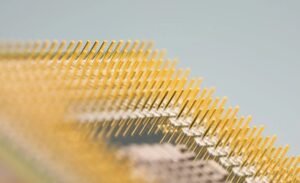What Is Production Possibilities Frontier?
The Production Possibilities Frontier (PPF) is a graphical representation of all possible combinations of two goods that an economy can produce given its limited resources and technology.
Key Takeaways:
- PPF shows the maximum outputs attainable when all resources are fully and efficiently employed.
- It demonstrates the concept of trade-offs and opportunity cost.
- PPF can help determine the most efficient allocation of resources for an economy.
In economics, the PPF illustrates the concept of scarcity, which means that resources are limited and choices have to be made.
The PPF assumes that resources are fully utilized, meaning that there is no waste or inefficiency in production.
Let’s consider an example to understand how the PPF works:
An Example of PPF:
Imagine an economy that produces only two goods: computers and cars. To produce more of one good, the economy must give up some production of the other good due to limited resources.
Table 1 below shows the production possibilities for this hypothetical economy:
| Computers | Cars | |
|---|---|---|
| Option A | 100 | 0 |
| Option B | 80 | 15 |
| Option C | 60 | 25 |
| Option D | 40 | 35 |
| Option E | 20 | 40 |
| Option F | 0 | 45 |
As shown in Table 1, the economy can produce up to 100 computers with no car production, or it can produce up to 45 cars with no computer production. Any combination between these extremes is also possible.
The production possibilities are graphically represented in Figure 1 below:
 |
In Figure 1, the PPF is represented as a concave curve, indicating the concept of increasing opportunity cost. As more of one good is produced, more and more of the other good needs to be sacrificed. This illustrates the trade-off between producing different goods.
Efficiency and Inefficiency:
On the PPF curve, all points represent efficient resource allocation. However, points inside the curve indicate inefficient use of resources, while points outside the curve are currently unattainable given the economy’s resources and technology.
Table 2 demonstrates the concepts of efficiency and inefficiency:
| Computers | Cars | |
|---|---|---|
| Option G | 75 | 20 |
| Option H | 90 | 28 |
In Table 2, Option G represents an inefficient allocation of resources, while Option H represents an efficient allocation on the PPF curve.
Understanding the PPF allows economists to analyze resource allocation, efficiency, opportunity cost, and trade-offs in an economy.
Conclusion:
The Production Possibilities Frontier (PPF) is a vital economic tool that illustrates the maximum production potential of an economy. It showcases trade-offs, opportunity costs, and the efficient allocation of resources. By utilizing the PPF, economists can gain valuable insights into resource management and decision-making in an economy.

Common Misconceptions
Misconception #1: Production Possibilities Frontier is a physical boundary
One common misconception about the Production Possibilities Frontier (PPF) is that it represents a physical boundary that cannot be crossed. However, the PPF is a theoretical model that illustrates the trade-offs between producing two different goods or services. It does not represent a physical constraint, but rather reflects the limits of resources and technology.
- The PPF can shift outward when there is an increase in resources or technological advancements
- Production can occur beyond the PPF if resources are misallocated or inefficiently utilized
- Changes in consumer preferences can also influence the shape and position of the PPF
Misconception #2: PPF only applies to economics
Another common misconception is that the concept of PPF is limited to the field of economics. While the PPF is widely used in economics to analyze efficiency, scarcity, and opportunity costs, it has applications in various disciplines.
- The PPF can be utilized in business decision-making to evaluate production possibilities and allocate resources
- In environmental science, the PPF can help assess the trade-offs between different activities and their impact on the environment
- In healthcare, the concept of PPF can be applied to evaluate resource allocation between different medical treatments
Misconception #3: PPF assumes fixed resources
Many people mistakenly believe that the PPF assumes fixed resources, meaning that the quantity and quality of resources do not change over time. However, the PPF model allows for changes in resources and their efficiency.
- Improvements in technology can increase the efficiency and productivity of resources
- New discoveries of resources can expand the available production possibilities
- The PPF curve can shift inward in case of resource depletion or technological setbacks
Misconception #4: PPF always assumes full employment
Some people assume that the PPF assumes full employment of resources, meaning that all available resources are utilized. However, the PPF can also illustrate situations of underutilization or unemployment of resources.
- Unemployment or underutilization of resources can result in a point below the PPF curve
- The PPF can demonstrate the opportunity cost of unemployment by showing the potential additional output that could be produced
- Policies and interventions such as training programs or economic incentives can help move the economy closer to full employment along the PPF curve
Misconception #5: PPF does not consider external factors
Many people mistakenly believe that the PPF only considers the production possibilities within an isolated system, excluding external factors. However, external factors can influence the PPF and its shape.
- Trade with other countries can allow a country to consume goods or services that are not produced domestically, affecting the PPF
- Changes in political or economic factors, such as government regulations or international agreements, can shift the PPF curve
- The PPF can be impacted by natural disasters or other unforeseen events that affect the availability of resources

The Basics of Production Possibilities Frontier
The concept of Production Possibilities Frontier (PPF) is a fundamental tool in economics that shows the maximum amount of goods or services that a country can produce given its resources and technology. It represents the trade-offs a country must make when allocating resources between the production of different goods or services. In this article, we will explore PPF through various tables, each highlighting a different aspect of this economic concept.
Table: Production Possibilities Frontier
This table illustrates a hypothetical PPF scenario for a country producing two goods: cars and computers. The country has limited resources and can choose to allocate them between the two industries. The table showcases different combinations of car and computer production, highlighting the concept of opportunity cost.
| Car Production | Computer Production |
|---|---|
| 0 | 10 |
| 1 | 9 |
| 2 | 7 |
| 3 | 4 |
| 4 | 0 |
Table: Efficient vs. Inefficient Points
This table presents two types of production points: efficient and inefficient. Efficient points represent the maximum possible output of one good given the production constraints imposed by the other good. In contrast, inefficient points underutilize resources and do not fully maximize production.
| Production Point | Car Production | Computer Production |
|---|---|---|
| Efficient | 3 | 4 |
| Efficient | 2 | 7 |
| Inefficient | 1 | 5 |
| Inefficient | 4 | 1 |
Table: Points Outside the Production Possibilities Frontier
This table showcases production points that lie outside the PPF curve. These points represent unattainable production levels given the country’s current resources and technology. They highlight the concept of scarcity and the need for resource allocation.
| Production Point | Car Production | Computer Production |
|---|---|---|
| Unattainable | 6 | 3 |
| Unattainable | 5 | 6 |
| Unattainable | 7 | 2 |
Table: Shifting the Production Possibilities Frontier
This table demonstrates the impact of technological advancement on the PPF curve. It showcases how an improvement in technology can shift the entire curve outward, enabling the country to produce more of both goods.
| Car Production | Computer Production |
|---|---|
| 0 | 10 |
| 1 | 9 |
| 2 | 8 |
| 3 | 7 |
| 4 | 6 |
Table: Trade-offs in Production
This table highlights the concept of trade-offs in production. It shows how as the country produces more of one good, it must sacrifice the production of the other good. The table quantifies the trade-offs between cars and computers at different production levels.
| Car Production | Computer Production |
|---|---|
| 0 | 10 |
| 1 | 9 |
| 2 | 7 |
| 3 | 4 |
| 4 | 0 |
Table: Attaining Full Potential of PPF
This table illustrates the production point that allows the country to fully utilize its resources and achieve the maximum potential output at the given technology level.
| Production Point | Car Production | Computer Production |
|---|---|---|
| Optimal | 3 | 4 |
Table: Inefficiency in Production
This table showcases inefficient production points, where resources are underutilized and not allocated optimally. It demonstrates the concept of wasted resources and the potential for improvement in production efficiency.
| Production Point | Car Production | Computer Production |
|---|---|---|
| Inefficient | 1 | 5 |
| Inefficient | 4 | 1 |
| Inefficient | 2 | 6 |
Table: Comparative Advantage
This table demonstrates the concept of comparative advantage, where one country can produce a good at a lower opportunity cost than another country. It compares the production possibilities of two countries: Country A and Country B.
| Production Point | Country A (Cars) | Country A (Computers) | Country B (Cars) | Country B (Computers) |
|---|---|---|---|---|
| Efficient | 3 | 4 | 2 | 8 |
| Inefficient | 1 | 5 | 3 | 6 |
Table: Economic Growth and PPF
This table illustrates the impact of economic growth on the PPF curve. It showcases how economic growth, through increased resources or technological advancements, can shift the PPF curve outward, enabling higher production levels.
| Car Production | Computer Production |
|---|---|
| 0 | 10 |
| 1 | 9 |
| 2 | 8 |
| 3 | 7 |
| 4 | 6 |
In conclusion, Production Possibilities Frontier (PPF) is a crucial tool in analyzing the efficient allocation of resources between different goods or services. Through the use of various tables, we have explored the trade-offs, opportunity costs, inefficiencies, technological advancements, and the impact of economic growth on the PPF curve. Understanding the concept of PPF provides valuable insights for policymakers, economists, and individuals in decision-making processes related to resource allocation and maximizing production efficiency.
Frequently Asked Questions
What is a production possibilities frontier?
The production possibilities frontier (PPF) is a graphical representation of all the possible combinations of two goods or services that an economy can produce using its limited resources efficiently.
What does the production possibilities frontier show?
The production possibilities frontier shows the maximum output levels an economy can achieve given its current resources and technology. It demonstrates the trade-offs between producing different goods or services.
What factors can cause a shift in the production possibilities frontier?
The production possibilities frontier can shift due to changes in factors such as technological advancements, changes in resource availability, improvements in labor productivity, and changes in the overall efficiency of the economy.
What is the opportunity cost represented by the production possibilities frontier?
The opportunity cost represents the value of the next best alternative foregone when a decision is made. In the production possibilities frontier, it is the quantity of one good that must be given up to produce more of the other good.
What does it mean if a point is inside or outside the production possibilities frontier?
If a point is inside the production possibilities frontier, it signifies an inefficient use of resources, as the economy is not producing at its maximum potential. If a point is outside the production possibilities frontier, it represents an unattainable combination of goods given the current available resources and technology.
How is the slope of the production possibilities frontier calculated?
The slope of the production possibilities frontier is calculated by dividing the change in the quantity of one good by the change in the quantity of the other good. It represents the opportunity cost between the two goods.
What are some assumptions underlying the production possibilities frontier?
Some assumptions underlying the production possibilities frontier include a fixed amount of resources and a constant level of technological knowledge. Additionally, it assumes that all resources are fully utilized and allocated efficiently.
What does a straight-line production possibilities frontier indicate?
A straight-line production possibilities frontier indicates a constant opportunity cost between the two goods. This suggests that resources are easily adaptable between the production of the two goods, maintaining a consistent trade-off.
How can a country improve its position on the production possibilities frontier?
A country can improve its position on the production possibilities frontier by investing in technological advancements, increasing the quantity and quality of its resources, fostering innovation, improving the education and skills of its workforce, and promoting efficiency in resource allocation.
Can the production possibilities frontier shift outward indefinitely?
No, the production possibilities frontier cannot shift outward indefinitely. There are limitations imposed by finite resources and technological constraints. However, through continuous advancements and improvements, the production possibilities frontier can expand over time.




